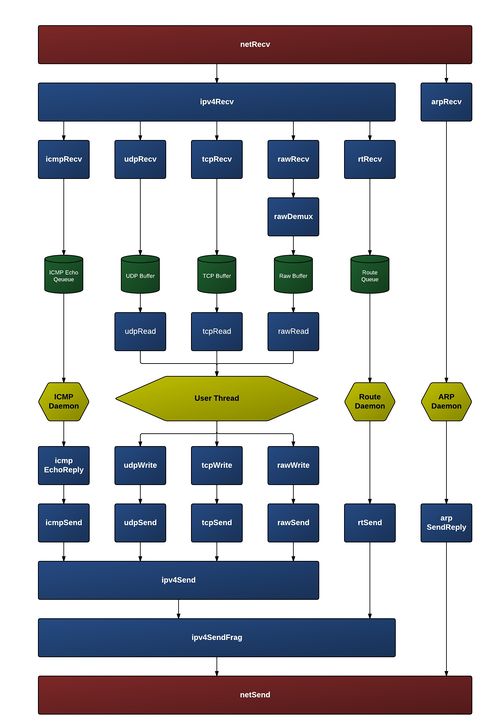Networking
XINU Networking Features
- TCP
- UDP
- ARP
- Routing
- ICMP
- TFTP client (development version only)
- DHCP client (development version only)
Design
The new network stack design does not have a NET device. The read and write device function paradigm does not map well to the network stack. TCP, UDP, and RAW sockets do not read from a network device, rather a network receive thread calls a chain of receive functions to process the packet at each layer in the network stack. A write function does not work well for sending a packet since the final destination of the packet is not known until the IP and/or ARP layers. The write device function assumes the thread calling write knows exactly which device to which the data should be written. A table of netif structures (separate from devtab, the table of devices) is still maintained to store configuration and accounting information for each underlying device (ETH, etc.) with which the network stack is receiving and sending packets.
A network interface is setup using the netUp command. An underlying device, IP address, mask, and gateway must be provided when calling netUp. DHCP functions as a separate process which runs before and netUp is called; DHCP interacts directly with the underlying device (ETH, etc.) without using the network stack.
Network receive threads continually read incoming packets from an underlying device. Each network interface has one or more network receive threads running. The netRecv function includes an infinite loop which reads a packet from the underlying device and calls ipRecv or arpRecv depending on the type of the packet. The packet is read into a buffer declared as a local variable within the netRecv function. At the IP layer ipRecv calls tcpRecv, udpRecv, rawRecv, or passes the packet to a routing thread. No sending of packets should ever occur under a network receive thread. For protocols in which an incoming packet may generate the need to send a reply packet, the protocol must have a separate thread for sending. For example, if an incoming TCP packet contains data which needs to be acknowledge, and tcpRecv should set a flag or send a message to a TCP monitor thread which will proceed to send the acknowledgement.
A global buffer pool is allocated for storing outgoing packets. One pool exists for use by all network interfaces. When sending a packet, the sending function (ex. tcpSend) obtains a buffer from the pool, calls the appropriate lower-level send function (ex. ipSend), and, after the function returns, returns the buffer to the pool.
The network stack is designed to treat the Xinu backend as both a router and a multi-homed host. Packets received on any of a backend's network interfaces may be destined for the backend or may need to be routed to another network destination. The network layer (IP layer) determines how to handle incoming packets. In the function ipRecv, the destination of an IP packet is compared against the IP address and broadcast address for every active network interface. If the destination address of the IP packet matches the IP address of the interface on which it was received or the IP address of any other network interface, the packet is passed to the appropriate transport layer receive function (udpRecv, tcpRecv, etc.). IP packets whose destination does not match with one of the active network interfaces are passed to the routing module of the network stack, i.e. the function rteRecv is called. In rteRecv the packet is copied into a buffer from the global buffer pool and placed on a queue for a routing thread to process. Currently, the network stack does not use a selective drop algorithm when the router is overloaded; once the queue of packets to route is full, all subsequent packets which require routing are dropped. A routing thread processes each packet on the routing queue. If no route is known, the packet is dropped; otherwise the TTL is decrement, the checksum is recalculated and the netSend function is called. Packets being sent from the transport layer (udpSend, tcpSend, etc) are not passed to the routing thread. The transport layer calls ipSend which performs a route table lookup, sets up the IP packet header and calls netSend.
